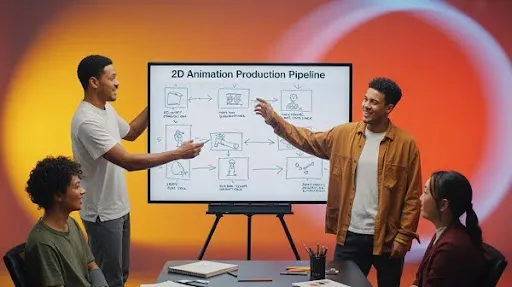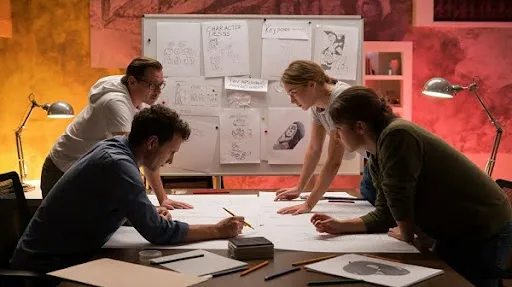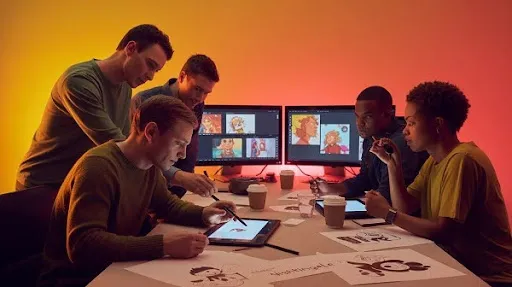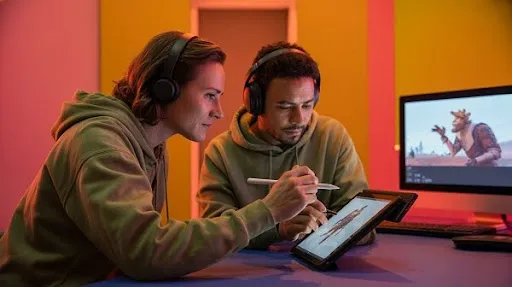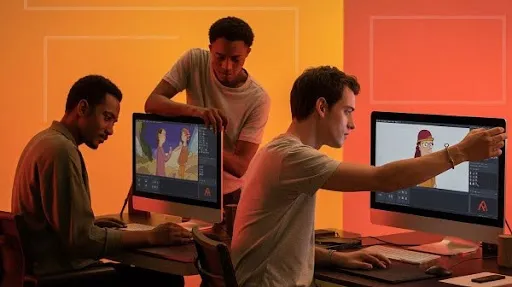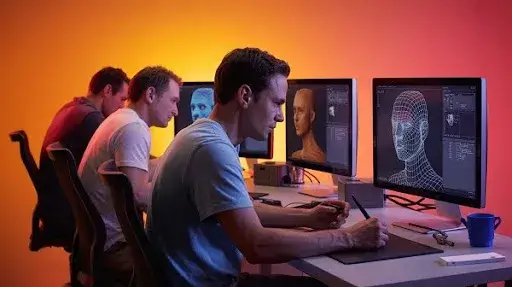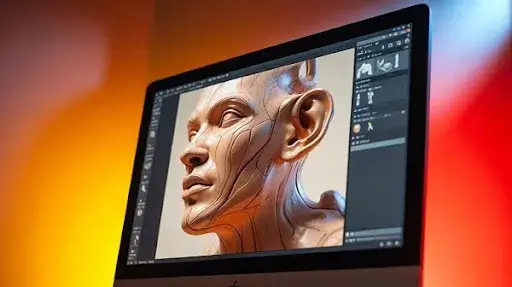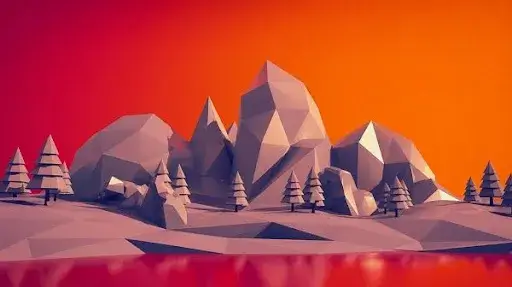2D animation isn’t just drawings sliding around a screen. It’s a mix of messy sketches, careful choices, and a whole lot of patience. What starts as a loose doodle ends up looking like a polished story people can connect with.
Every tiny movement, every eye blink, every pause, every tilt, has intent behind it. Holding all of this together is something called the 2D animation pipeline, the roadmap that keeps a project from spinning out of control.
The market for 2D animation software was estimated at approximately USD 5.64 billion in 2024 and is projected to reach nearly USD 12 billion by 2035, expanding at a CAGR of roughly 7.1% from 2025 to 2035.
At Prolific Studio, the pipeline isn’t a prison. It’s more like guardrails on a highway. With the steps laid out, animators can experiment without the whole project going off track. For clients, that translates into animations that not only look smooth but also make sense, are consistent, clear, and emotionally sharp.
This article walks through the stages in the 2D animation pipeline. Think of it as a behind-the-scenes look at how professional teams turn a napkin sketch into something worth watching.
Significance of 2D Animation Pipeline
Watch a finished animation, and it feels effortless. In reality, it’s hours, sometimes weeks, squeezed into seconds. Even a five-second clip can chew through piles of drawings, script edits, and multiple review rounds. Skip the structure, and you’ll notice it immediately: timing feels weird, shots don’t connect, and deadlines slip away fast.
That’s why the processes in 2D animation production are so important. Each role sets up the next. Writers hand off to storyboard artists. Rigging specialists make life easier for animators. Compositors add polish once everything else is ready. The pipeline isn’t about strict rules; it’s about giving everyone a shared rhythm so nothing falls apart.
For businesses, knowing this workflow pays off. Brands that want ads, explainer videos, or training pieces get a clearer idea of why professional 2D animation services matter. It also explains why skipping steps usually costs more later, because fixing mistakes mid-project is never cheap.
The Stages in the 2D Animation Pipeline
Most studios boil the process down into three big chunks:
- Pre-production: planning, scripting, design.
- Production: actually animating.
- Post-production: editing, sound, polish, and delivery.
Miss one step, and the other two start wobbling.
Pre-Production in the 2D Animation Pipeline
High-Concept Animation Idea
Every project kicks off with a core idea. But it can’t just be “let’s make a cartoon.” It has to be a high-concept animation idea that sets the direction. Is it playful? Serious? Educational? Once the tone is clear, decisions about style, colors, and pacing fall into place.
At Prolific Studio, clients often walk in with a broad goal, say, explaining a complicated product. The team builds on that, shaping it into a concept that grabs attention and sticks.
Animation Scriptwriting
Ideas float until they’re nailed down in writing. That’s the job of animation scriptwriting. Dialogue, actions, scene transitions, it all gets pinned to the page.
The script isn’t just words; it’s timing. A single line might hint at a pause that makes a gag land. Another line tells the “camera” to pan slowly for drama. Without that structure, even great art risks falling flat.
Animation Storyboarding
Scripts organize the story. Storyboards show how it looks. Animation storyboarding turns written scenes into sketches, like a rough comic strip.
The drawings don’t need to be pretty. They just need to make sense. Storyboards reveal pacing problems, awkward staging, or cluttered frames early. Fixing them here is painless compared to fixing them after production starts.
Animatic
Once storyboards are locked in, they’re strung together into an animatic. This version adds basic timing and temporary audio so everyone can see how the story flows.
Animatics are the safety net. They point out where jokes fall flat or where pauses drag. For clients, it’s often the first time the animation feels real rather than just a pile of sketches.
Concept Art and Design Direction
Next comes style. Concept art sets how characters, props, and environments will look. Artists try different shapes, lines, and colors until the mood feels right.
Consistency matters. A corporate explainer shouldn’t look like a Saturday cartoon. A kids’ ad shouldn’t feel dark or heavy. Locking the design direction now keeps the visuals steady later.
Production in the 2D Animation Pipeline
Pre-production clears the road. Production is where things actually start moving.
Layout
Layout artists translate storyboards into more detailed frames. They pick camera angles, place characters, and define backgrounds. It’s like arranging a set before the actors walk in.
Previously in 2D animation, layouts were done on paper, but today, specialized animation software makes it faster. The goal, however, remains the same; to give animators a clear guide to ensure the scenes do not fall apart.
Character and Environment Design
Here’s where characters and settings get finalized. Designers create model sheets that display characters in multiple poses, ensuring every animator remains consistent. Background artists add depth, textures, and props.
Together, these animation elements bring the world to life.
Rigging for Efficiency
Rigging chops characters into movable parts, arms, legs, eyebrows, you name it. That way, animators don’t have to redraw everything.
Without rigging, projects become labor-intensive animation nightmares. With rigging, deadlines are easier to hit, and budgets don’t explode.
Key Animation: The Core Process
Key animation is the backbone. Animators draw the critical poses, the punch, the leap, the laugh. These frames hold the emotional weight.
If they’re stiff, nothing works. Strong keyframes give the whole animation rhythm and life.
Inbetweening
On their own, keyframes look jumpy. Inbetweening smooths things by adding drawings between them. More in-betweens mean smoother, more detailed animation; fewer mean faster but rougher results.
Different types of animation use this step differently. TV animation often keeps it light. Feature films go heavy for silky-smooth motion.
Compositing
Now the magic of layering begins. Compositing takes disparate scenes and blends them into a single cohesive work. Characters, backgrounds, effects, colors, and overall lighting are adjusted, and errors are corrected.
This is where it stops feeling like pieces and starts feeling like a film.
Post-Production in the 2D Animation Pipeline
Once production ends, polish takes over. Animation production and post-production finalize the piece.
Editing
Editors cut and rearrange until the story flows naturally. Trim one second, and the mood changes. Comedy lives on sharp timing. Drama needs breathing space.
Editing is where the rhythm locks in and the project finally feels complete.
Sound Design and Voice Work
Animation doesn’t only hit the eyes, it hits the ears too. Soundless animation is incomplete. A character stumbles, and there is no thud; a mouth moves, but no words come out. The absence of sound is awkward and unsettlingly to the viewer.
That’s where voice actors and sound designers step in. The actor sets the personality. A nervous intern doesn’t sound like a confident narrator, and a goofy sidekick shouldn’t sound like a CEO. At Prolific Studio, one of the best animation studios in Baton Rouge, we take casting as seriously as drawing, because one wrong voice and the illusion breaks.
Then there is the subtle stuff: the creak of a chair, footsteps on gravel, and that silence before a punchline. The details make the work convincing, and the illusion of weight is tricked into the viewer.
Music Scoring
Music is also a form of trickery; it is unnoticed, but when it is absent, it is felt. A score can emotionally manipulate an audience toward suspense, sadness, and excitement all at once without words.
Picture a product demo with no music, and it just drags. Now, picture the same video with a light upbeat track running underneath, and it suddenly feels crisp and engaging. That’s the power of music in animation.
Sometimes studios license existing tracks, but original scoring is where the magic happens. A custom piece of music bends and shifts perfectly with the visuals. For kids’ animation, that might be something playful and bouncy. For a brand film, maybe something sleek and cinematic. Either way, the right track sets the mood before a character even speaks.
Quality Control and Review
This part isn’t glamorous, but it saves projects from disaster. Once the animation looks stitched together, the team combs through it again and again. Are characters drifting off-model? Did a mouth flap too late? Is the timing just slightly off? These are the things most viewers don’t consciously notice, but they’ll “feel” them if they’re wrong.
Clients get involved here, too. Their feedback ensures the tone matches what they had in mind. Skipping this step to save time? That’s usually how tiny errors slip through and ruin weeks of effort.
Delivery and Formats
“Final delivery” sounds like one neat file, but it’s rarely that simple. Platforms all want different formats. YouTube loves widescreen. TikTok and Instagram demand vertical. A training video for an office might need high-resolution playback for a big projector.
If a studio doesn’t prepare multiple outputs, a polished ad can suddenly look cropped or blurry in the wrong setting. That’s why delivery is its own mini-stage, less creative, but vital for businesses that want their animation to shine everywhere.
Why This Pipeline Helps Businesses
For companies, understanding the 2D animation pipeline isn’t about turning them into animators; it’s about setting expectations. Here’s the payoff:
- Realistic timelines. Knowing that a short clip can still take weeks makes deadlines less frustrating.
- Cleaner collaboration. When a client understands storyboards or animatics, their feedback becomes sharper and less vague.
- Money saved. Pre-production might feel slow, but skipping it usually costs more once revisions pile up.
- Consistent branding. Each stage keeps the look, feel, and tone locked to the brand voice.
For clear communication and trust, most businesses now opt for professional 2D animation instead of DIY tools. A video is not just about looking pretty; it intricately showcases its message.
Roadblocks in 2D Animation Production
Even with a good process, projects hit bumps:
- Scope creep. A client asks for “just one more scene,” and suddenly the schedule explodes.
- Time crunch. Skipping or rushing storyboards almost always backfires.
- Feedback gaps. Vague comments like “make it pop” slow everything down.
- Budget bloat. Hand-drawing every detail without rigging or reuse? Costs spiral fast.
These headaches are common, but a structured pipeline keeps them from turning into disasters.
Where 2D Animation Is Headed
2D isn’t dying; it’s shifting gears. New tools like Toon Boom and Adobe Animate accelerate the process, while AI assists with repetitive tasks. But here’s the truth: software may evolve, yet storytelling and strong design stay at the core.
Some trends already shaping the industry:
- Interactive learning animations for schools and workplaces.
- Mixed media projects, blending 2D with 3D or motion graphics.
- Short, vertical content tailor-made for social feeds.
- AI-assisted rigging to free animators from repetitive grunt work.
For businesses, this means faster delivery times and more flexibility without losing the handcrafted feel of traditional 2D.
Frequently Asked Questions
How long does a project usually take?
Depends on the scope. A simple explainer can be done in a month. A short film? Several months.
Why does pre-production eat so much time?
Because catching mistakes early is cheaper than fixing them once animators start drawing.
What tools do studios rely on?
Harmony, Adobe Animate, After Effects, plus editing and compositing software.
Can we skip animatics?
You could, but it’s like building a house without a floor plan. Risky and expensive if something’s wrong.
Is 2D cheaper than 3D?
Not always. Hand-drawn projects with high detail can match or exceed 3D costs.
How can businesses stretch their budget?
Be clear about goals, provide focused feedback, and trust the pipeline.
Final Words
The pipeline may sound like inside baseball, but it’s the safety net holding everything together. Every stage exists for a reason, and when one gets skipped, you can feel it in the final product.
For companies, investing in structured 2D animation production isn’t just about nice visuals. It’s about consistency, clarity, and making sure their message lands the way it should. In a crowded digital space, that edge matters more than ever.

